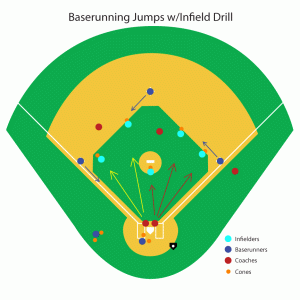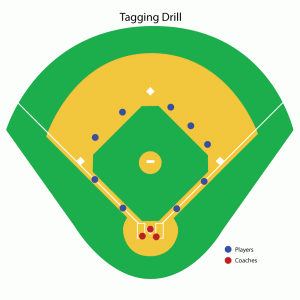Purpose
In the game of T-ball, I believe one of the most underrated and neglected aspects of the game is baserunning. When it comes to games, baserunning is often the difference in whether teams win or lose games. I would say that over 50% of the outs recorded could have been avoided with proper baserunning. Yet, I don’t think coaches spend much time on it because it’s a difficult and frustrating skill to teach 5 & 6 year olds. And the generic “run around the bases” after practice doesn’t help much because it’s not simulating the game situation and most T-ball kids run station to station on each hit. The first important thing a kid needs to understand is how to get a good jump. And this is probably the easiest part of baserunning to teach. This drill will teach the kids how to get a good jump, taking off on the swing of the bat.
This drill is designed for T-ball aged kids, but can also be important for any age kid that plays tight bases. There are 2 versions of this drill: 1 for small groups that focuses on only baserunning, and one for larger groups that incorporates some infield practice as well (to ensure all kids stay active). In this large group, full squad drill, half of the kids will be runners, and half will be be infielders.
Setup
- Place cones in the infield where each kid will be playing. This helps speed up the drill so that each kid does not have to be positioned each time.
- Load the bases with 3 kids, and put one at home plate to act as the batter. Have the rest lineup behind a cone near home plate, but out of the way.
- Place 2 coaches at home plate, 1 coach as the 1B coach, and 1 as the 3B coach. If you have extra help, a coach can stand behind 2B as well to help instruct the runners at 2B. However at some point they’ll have to be able to do it on their own at 2B because you won’t have a coach there in games.
- Give the batter a plastic bat. They will swing it to simulate game situation, but will not hit a ball.
Baserunning Procedure
- Demonstrate at 1B to the kids how to position their feet on the base when the batter is ready to hit. One foot on the edge of the base ready to push off, and the other foot out in the dirt. Age young ages its preferable to teach them to put the left foot on the base and right foot in the dirt because this allows their body to be in a better position to see the batter.
- Explain to them that as soon as the batter swings, they are to explode off the base like a sprinter hearing a starting gun. I show our kids a video of Usain Bolt winning a 100m sprint. That’s what they should be running like from base to base, anticipating the swing to get a quick start.
- With the bases loaded, give the batter a plastic bat. Have the batter get in the batters box, position his feet and take his swing. On the swing, all runners should be off and running. If they are not getting a good jump, help them.
- if you are keeping score, the kid that gets to his next base first is the winner.
- Continue until all kids have rounded the bases at least once.
Infield Defense Procedure
- Explain to the P and 2B’man that if the ball comes to them, they will throw the ball to 1B. Explain to the 3B and SS that they will field the ball and step on their base. Explain to the 1B’man that he will cover 1B for the P and 2B or will field the ball and step on his base if the ball comes to him.
- The infield will work in 2 groups. 3B/SS will be a group, and P/2B/1B will be the other group. 1 coach near home will be assigned to each group for the purpose of rolling ball them them.
- When the batter swings the bat, the 2 coaches near home will roll a ball to a kid in their group. They are try to get an out. Left side should go for a force out at 3B or 2B. Right side should attempt to get the out at 1B.
- After a certain # of ball have been rolled (at least 1 to each kid), rotate the fielders and continue. Continue rotating until all fielders have played each position.
- At this point, swap the Infield group and the Baserunning group and start over.
Additional Notes
- Make sure the baserunners are running through 1B and home, but not 2B or 3B. They can practice sliding at 2B and 3B if they are able.








